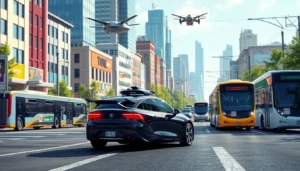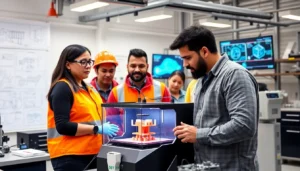Table of Contents
ToggleIn the fast-paced world of technology, Robotic Process Automation (RPA) is like that friend who shows up to the party with snacks—everyone’s happy to see it, and it makes everything run smoother. But where does RPA fit in with other emerging technologies like AI, machine learning, and blockchain? It’s the ultimate team player, bridging the gap between human effort and machine efficiency.
As businesses scramble to adopt the latest innovations, understanding RPA’s role becomes crucial. It’s not just about automating mundane tasks; it’s about enhancing productivity and freeing up human brains for more creative endeavors. So, buckle up as we explore how RPA integrates with these cutting-edge technologies, proving that sometimes the best partnerships are the ones that make work feel a little less like work.
Understanding RPA
Robotic Process Automation (RPA) transforms how businesses approach routine tasks. In an age where efficiency matters, RPA integrates seamlessly with other technologies to enhance workflows.
Definition of RPA
RPA refers to software technologies that automate repetitive tasks. This automation mimics human actions to execute business processes quickly and accurately. By utilizing RPA, organizations streamline operations, reduce errors, and minimize the time spent on mundane tasks. RPA can operate across multiple applications and systems without extensive programming. Industries like finance, healthcare, and manufacturing benefit significantly from RPA’s capabilities, simplifying complex workflows and enabling personnel to focus on higher-value activities.
Key Features of RPA
RPA boasts several features that distinguish it from traditional automation. First, it requires minimal coding, allowing non-technical users to create automated workflows. Second, RPA supports integration with existing software systems, providing flexibility in deployment. Third, it offers scalability, enabling organizations to adjust their automation efforts as demand fluctuates. Fourth, its ability to gather and analyze data enhances decision-making processes. The combination of these features results in improved productivity alongside decreased operational costs, making RPA an essential tool in the modern digital landscape.
The Role of RPA in Automation

RPA plays a critical role in modern automation efforts across various industries. Its ability to streamline workflows makes it a valuable addition to the technological arsenal.
RPA vs. Traditional Automation
RPA differs significantly from traditional automation approaches. Traditional automation often requires extensive coding and major changes to existing systems. In contrast, RPA focuses on mimicking human actions without the need for heavy coding. Many businesses appreciate RPA’s ability to integrate seamlessly with legacy systems, preserving existing investment. While traditional automation can offer efficiency, it often demands a larger upfront investment in infrastructure. RPA provides a quicker, more flexible solution, addressing immediate process improvement needs.
Benefits of Integrating RPA
Integrating RPA offers numerous benefits for organizations. Increased efficiency stands out as a primary advantage, often resulting from automating repetitive tasks. Mistake reduction follows closely behind, with RPA minimizing human errors in data entry or processing. Scalability represents another key benefit, enabling companies to ramp up operations without a proportional increase in workforce size. Enhanced compliance also emerges as organizations can better track processes and maintain regulatory standards with RPA. Furthermore, RPA allows employees to focus on higher-value tasks, fostering innovation within teams.
RPA and Other Emerging Technologies
RPA integrates effectively with various emerging technologies, enhancing productivity and innovation across sectors.
RPA and AI
RPA combines seamlessly with AI to automate complex tasks. This collaboration enables businesses to benefit from enhanced decision-making capabilities and improved data processing. AI algorithms analyze data patterns, while RPA automates routine actions based on these insights. For instance, in customer service, RPA can manage inquiries, and AI can provide personalized responses. Together, they create a powerful solution that streamlines operations and elevates user experiences.
RPA and Machine Learning
RPA and machine learning work together to improve automation processes. Machine learning algorithms analyze historic data and identify trends, which RPA can then apply to automate workflows. By incorporating these insights, organizations enhance accuracy in task execution and respond dynamically to changes. For example, in finance, RPA can process transactions while machine learning flags anomalies for further review. The synergy between RPA and machine learning leads to smarter automation solutions that adapt to evolving business needs.
RPA and IoT
RPA plays a critical role in leveraging IoT technology for enhanced efficiency. With IoT devices generating massive data volumes, RPA automates the collection and analysis of this information. Businesses can monitor real-time data through RPA, maximizing operational performance and identifying areas for improvement. For example, in manufacturing, RPA can collect data from IoT sensors and trigger maintenance alerts to prevent downtime. This integration not only optimizes processes but also fosters a proactive approach to equipment management.
Industry Applications of RPA
RPA finds extensive applications across various industries, transforming operational efficiency and driving growth.
RPA in Finance
RPA enhances financial institutions by automating routine tasks such as invoice processing, reconciliation, and fraud detection. Automation reduces processing times from days to mere hours, significantly increasing productivity. Financial analysts benefit as RPA minimizes manual entry errors in transactions, promoting accuracy in reporting. With compliance demands rising, RPA assists in ensuring regulatory adherence by maintaining detailed audit trails. Institutions that implement RPA experience improved customer service through faster transaction handling, allowing personnel to prioritize complex inquiries.
RPA in Healthcare
In the healthcare sector, RPA improves patient care by automating administrative tasks like scheduling and patient data management. Automation reduces the administrative burden on staff, enabling more focus on patient interaction. It also streamlines claims processing and billing, enhancing revenue cycle management. Hospitals utilizing RPA report lowered operational costs, translating to better resource allocation in patient services. Moreover, compliance with healthcare regulations improves through automated reporting, ensuring accurate and timely submissions. RPA’s role in healthcare underscores its ability to drive operational efficiencies and improve service delivery.
Challenges and Considerations
Implementing Robotic Process Automation (RPA) presents notable challenges. Organizations must address integration with existing systems, as RPA often interacts with various software environments. Resistance to change from employees can emerge, complicating implementation. Effective change management strategies help alleviate these issues. Additionally, organizations face a learning curve associated with RPA technologies. Training staff becomes essential to maximize tool usage and performance. Data privacy concerns arise, prompting firms to establish compliance protocols that safeguard sensitive information. Addressing these challenges requires careful planning and resource allocation to ensure successful RPA adoption.
Implementation Challenges
Integration complexities often hinder RPA projects. Direct connections between RPA tools and legacy systems may encounter compatibility issues. Organizations should prepare for extensive testing to ensure seamless operation. Change resistance frequently complicates the implementation process. Employees may fear job loss due to automation, affecting morale. Training programs become critical to boost confidence and demonstrate RPA’s role as a supportive technology. Limited technical skills within teams can also pose a challenge. Establishing clear communication about RPA’s functions aids in easing concerns and encourages buy-in.
Future of RPA in Technology
RPA’s evolution continues alongside emerging technologies. Predictions indicate increased collaboration between RPA and AI as organizations seek enhanced automation capabilities. Greater efficiency appears likely as RPA integrates deeper machine learning insights. Demand for intelligent automation rises, driving innovations that will redefine workflows. Businesses increasingly explore RPA’s role in process optimization, especially in data-driven industries. Advancements in RPA capabilities position it as a cornerstone of digital transformation. Future implementations may focus on proactive monitoring and predictive analytics, expanding RPA’s applicability across various sectors.
RPA stands at the forefront of technological innovation by seamlessly integrating with other emerging technologies. Its ability to automate repetitive tasks not only enhances productivity but also fosters creativity within organizations. As businesses navigate the complexities of digital transformation, RPA’s collaborative potential with AI, machine learning, and IoT becomes increasingly vital.
This synergy not only streamlines operations but also empowers employees to focus on higher-value tasks. With its minimal coding requirements and adaptability, RPA continues to prove itself as an essential tool in driving efficiency and innovation across various industries. Embracing RPA is a strategic move for organizations looking to thrive in an ever-evolving technological landscape.







